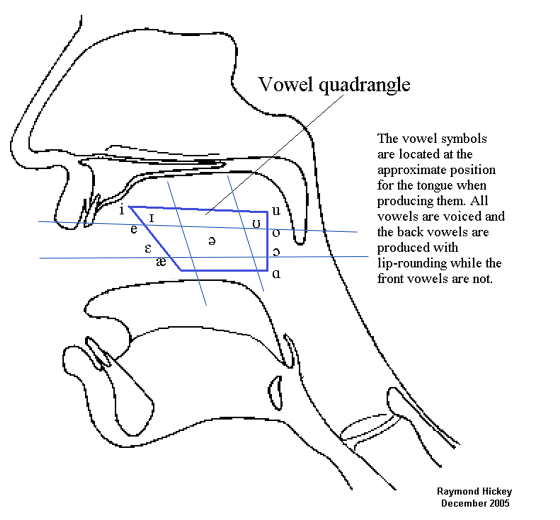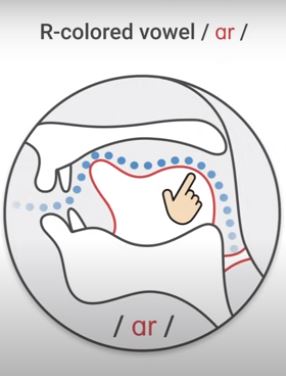1 Chapter 1 – Vowel Sounds
INTRODUCTION
In English, five or six letters are used to represent vowels in writing: a, e, i, o ,u and sometimes y. Unfortunately, there are many more vowel sounds than five or six in English. There are not enough letters in the alphabet to represent all the English vowels.
To represent the pronunciation of all vowels (and consonants), we will use a different kind of alphabet called the International Phonetic Alphabet or the IPA. You will not need to learn the symbols in the IPA, but we will use them from time to time to help distinguish the sounds.
By the end of the chapter, readers will be able to…
- recognize some symbols in the IPA
- describe how individual vowels are produced
- describe how vowel diphthongs are produced
- produce vowel sounds and diphthongs in different words and phrases
HIGH-LOW, FRONT-BACK, AND (UN)ROUNDED VOWELS
An introduction to the pronunciation of vowels requires a little understanding of how the sounds are made in the mouth. It’s also important to hear the sounds individually and in words.
This video from Ubc Visible Speech provides an overview of the pronunciation of vowels.
There are two kinds of vowel sounds monophthongs and diphthongs. Monophthongs have one vowel sound such as in the words “cat” and “sit.” Diphthongs have two vowel qualities. More information about diphthongs is given below.
Three criteria are used to describe the pronunciation of vowels: height, backness, and roundedness. These criteria refer to the position of the tongue and the lips.
- Three tongue positions refer to height: high, mid, low.
- Three tongue positions refer to backness: front, central, back
- Roundness refers to whether the lips are rounded or unrounded.
You can see the positions in this illustration of the vocal tract. The high vowels are represented by the IPA symbols [i], [ι], [ʊ], and [u].
The low vowels are represented by the symbols [æ] and [a]. The front vowels are [i], [ι], [e], [ɛ], and [æ] and the back vowels are [u], [ʊ], [o], [ɔ], and [a]. The mid central vowel is the shwa represented by [ə].
The Vocal Tract

Words with High-Low, Front-Back, and (Un)Rounded Vowels

TENSE AND LAX VOWELS
Vowels can be tense or lax. Tense vowels are pronounced with more tension in the vocal tract and lax vowels are pronounced with less tension. This video from Learn English with TIE explains differences between tense vowels and lax vowels. Sometimes these vowels are referred to as short and long but a more accurate way to describe them for pronunciation is tense and lax.
Tense vowels are pronounced with more tightness in the tongue, lips, and mouth more generally. Lax vowels are pronounced in a more relaxed way with less tension. Practice the sounds and words with the speaker in the video to feel the difference between tense vowels and lax vowels.
Now listen to the the audio file and look at the words below. Listen for the difference between tense and lax vowels
Words with Tense and Lax Vowels
- beat (Tense) — bit (Lax)
- bait (Tense) — bet (Lax)
- boot (Tense) — book (Lax)
- boat (Tense) — bought (Lax)
The tense vowels, however, are not “pure” vowels. They are pronounced with a slight offglide. The offglide adds a brief [y] or [w] sound to the vowel. The sounds [i], [e], [u] and [o] are actually pronounced as: [iy], ey], uw], [ow].
DIPHTHONGS: [aι], [aʊ], and [ɔι]
Diphthongs are two vowel sounds pronounced together as in the words lie, cow, and toy. The linguistic symbols that represent these words are: [laι] for lie, [kaʊ] for cow, and [tɔι] for toy. Notice that two linguistic symbols are used to represent the two vowel sounds, which are pronounced together.
The [aι] Diphthong
This video from Sounds American explains and gives examples of how the diphthong [aι] is pronounced. To hear the sound and see a diagram, click on the video. At the end of the video (minute 8:22), the speaker considers the sounds [eι] as in face and [oʊ] as in no. Are these sounds diphthongs or monophthongs? One similarity with diphthongs is that both [eι] and [oʊ] are pronounced as moving or “gliding sounds,” which makes them like diphthongs. When studied carefully, however, there is not quite as much movement in the vocal tract when these two sounds are pronounced when compared with [ɔι], [aʊ], and [aι]. The takeaway point is that the tongue, jaw, and lips need to move a lot when pronouncing English vowels, especially diphthongs.
The [aʊ] Diphthong
When pronouncing [aʊ] as in the word round, begin with a low vowel. This means you will need to lower your jaw. Then, move your tongue to a high back position and round your lips. When this diphthong is pronounced as a stressed sound as in round, the jaw is lower and the sound is held longer. The diphthong can also be unstressed and shorter. In this case, the jaw is not as low and the lips are not as rounded. An example is the word shutdown as in the sentence, “the governmental shutdown caused many problems.” This video from Rachel’s English provides a good example of how this diphthong is pronounced.
The [ɔι] Diphthong
The next diphthong is [ɔι] as in the words joy, point, and soil. This sound begins with a mid-back vowel and some lip rounding. Then, the tongue moves to the high, front position and the lips are unrounded. This short video from bbclearningenglish.com shows how this sound is made. It is important to see how the jaw and lips move to pronounce this sound in words such as: choice, noise, and boy. The speaker has a British accent, but the sound is quite similar to the North American pronunciation.
THE NORTH AMERICAN R-SOUND AND SOME R-DIPHTHONGS
For some people, the r-sound can be difficult to pronounce. A reason for the difficulty is that this sound is pronounced in different ways depending on the country and the region of the country. To make it easier to pronounce, the examples and illustrations used here are typical of the North American r-sound and r-diphthongs.
Tense and Lax R-Sound
The r-sounds [ɝ] and [ɚ] are vowels and their pronunciation is similar. The [ɝ] sound is tense and stressed as in the word first. The sound [ɚ] is not stressed, so it sounds “weaker” as in the word after. A description of this sound and some example are in this video from Sounds American.
The R-Colored Vowel [ir]
The r-sound can also be a diphthong when it combines another vowel. The addition of the r-sound slightly changes the vowel sound. This change can be described as “adding some color” to the vowel sound, so this sound is sometimes called r-colored vowels. An example is the vowel [ι] + [r] as in words like hero, here, clear, deer, and zero. The North American and British pronunciations of this “r-colored” sound are different. For instance, the word deer is pronounced as [dιr] in many places in North America. In British English, however, the [r] sound is reduced to [ə]. The word deer is pronounced as [dιə]. This video from Sounds American has diagrams of how this sound is pronounced in North America and offers examples from words such as appear, career, and cheer.
The R-Colored Vowel [ɔr]
Like all diphthongs, the key to pronouncing this sound is to make a smooth connection between sounds, in this case between the [ɔ] and the [r]. This r-colored vowel is in words such as sport, four, orange, and sword. Some speakers of North American English pronounce this diphthong as [o] + [r] rather than [ɔ] + [r]. Either way is fine! We can see an illustration of how this sound is pronounced in the vocal tract and hear examples of the pronunciation in this video from Sounds American.
The R-Colored Vowel [ar]
When pronouncing r-colored diphthongs, be sure not to reduce the [r] sound. To pronounce this diphthong, start with the [a] sound. Lower your jaw to open your mouth wide and place your tongue low and flat at the bottom of your mouth. Then, transition to the [r] sound by rounding your lips, curling the tip of your tongue, and “bunching” the back of the tongue as show in the diagram below.

This video from Sounds American offers more explanation and examples of how to produce this vowel.
The R-Colored Vowel [ɛr]
This diphthong appears in words such as air, care, fair, hair, share, and bear. The first sound in this diphthong is the mid, front, lax vowel [ɛ] as in the word bet. To pronounce the diphthong, start with [ɛ] and then move your tongue into the [r] sound. This video from Speech Modification Accent Training models the pronunciation of [ɛr] in three words: air, care, and airport. Notice that the [r] sound at the end of a word can connect or blend with the beginning sound of the next word as in care + about, which is pronounced as “care-rabout.” (The “e” in care is not pronounced.)
MINIMAL SETS
Minimal sets are words that differ by only one sound. Below are words that differ in the pronunciation of the vowel sound. One small difference in pronunciation, and the word has a different meaning. Listen to the different vowel sounds in these words.
Pete – pit – pet – pat – put – putt – pot
so – saw – see – sigh – Sue – sir
neat – knit – not – note – nut
heed – hid – head – had – hard – heard

